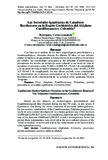Mostrar el registro sencillo del ítem
Las Sociedades Igualitarias de Cazadores Recolectores en la Región Geohistórica del Altiplano Cundiboyacense, Colombia
| dc.rights.license | http://creativecommons.org/licenses/by-nc-sa/3.0/ve/ | es_VE |
| dc.contributor.author | Rodríguez, Carlos Armando | |
| dc.date.accessioned | 2021-12-02T19:37:02Z | |
| dc.date.available | 2021-12-02T19:37:02Z | |
| dc.date.issued | 2021-12-02 | |
| dc.identifier.uri | http://www.saber.ula.ve/handle/123456789/47715 | |
| dc.description.abstract | Con base en el análisis de los datos arqueológicos, paleobotánicos y bioantropológicos, obtenidos durante los últimos 50 años, en este artículo, planteo la hipótesis de que durante la formación social de cazadores recolectores pre-tribales, las comunidades precerámicas del Altiplano Cundiboyacense, presentaron dos niveles de desarrollo socio-cultural: a) un modo de vida de cazadores recolectores, entre 23.000 y 10.000 A.P. (Nivel 1 de complejidad), y b) un modo de vida productor temprano de alimentos, entre 10.000 y 3.550 A.P. (Nivel 2 de complejidad). En este último período, estas comunidades se involucraron en el proceso sociocultural de la “revolución tribal”, que desembocaría en la conformación de la sociedad tribal igualitaria Herrera Temprano. | es_VE |
| dc.language.iso | es | es_VE |
| dc.rights | info:eu-repo/semantics/openAccess | es_VE |
| dc.subject | Altiplano Cundiboyacense | es_VE |
| dc.subject | Colombia | es_VE |
| dc.subject | Colombia | es_VE |
| dc.subject | período precerámico | es_VE |
| dc.subject | sociedades igualitarias | es_VE |
| dc.subject | revolución tribal | es_VE |
| dc.title | Las Sociedades Igualitarias de Cazadores Recolectores en la Región Geohistórica del Altiplano Cundiboyacense, Colombia | es_VE |
| dc.title.alternative | Egalitarian Hunter-Gatherer Societies in the Geohistoric Region of The Altiplano Cundiboyacense, Colombia | es_VE |
| dc.type | info:eu-repo/semantics/article | es_VE |
| dcterms.dateAccepted | 29-10-2021 | es |
| dcterms.dateSubmitted | 19-10-2021 | es |
| dc.description.abstract1 | Based on the analysis of archaeological, paleobotanical and bioanthropological data obtained during the last 50 years, in this article, I hypothesize that during the social formation of pre-tribal hunter-gatherers, the pre-ceramic communities of the Cundiboyacense Altiplano presented two levels of socio-cultural development: a) a hunter-gatherer way of life, between 23,000 and 10,000 B.P. (Level 1 of complexity), and b) an early food-producing way of life, between 10,000 and 3,550 B.P. (Level 2 of complexity). In this last period, these communities were involved in the socio-cultural process of the "tribal revolution", which would lead to the conformation of the Herrera Early tribal egalitarian society | es_VE |
| dc.description.colacion | 316-363 | es_VE |
| dc.description.dependencia | Museo Arqueológico “Gonzalo Rincón Gutiérrez” | es |
| dc.description.email | carlos.a.rodriguez@correounivalle.edu.co | es_VE |
| dc.description.frecuencia | Semestral | es |
| dc.description.paginaweb | www.saber.ula.ve/boletin_antropologico | es |
| dc.identifier.eissn | 2542-3304 | es |
| dc.publisher.pais | Venezuela | es_VE |
| dc.subject.institucion | Universidad de Los Andes | es_VE |
| dc.subject.keywords | Cundiboyacense Highlands | es_VE |
| dc.subject.keywords | Colombia | es_VE |
| dc.subject.keywords | preceramic period | es_VE |
| dc.subject.keywords | egalitarian societies | es_VE |
| dc.subject.keywords | tribal revolution | es_VE |
| dc.subject.seccion | Boletín Antropológico: Artículos | es_VE |
| dc.subject.tipo | Revistas | es_VE |
| dc.type.media | Texto | es_VE |
| dc.identifier.doi | http://doi.org/10.53766/BA/2021.02.102.04 | es |
| dc.contributor.orcid | http://orcid.org/0000-0002-4765-9123 | es |
Ficheros en el ítem
Este ítem aparece en la(s) siguiente(s) colección(ones)
-
Boletín Antropológico - Num 102 - Vol 2
Julio - Diciembre 2021


